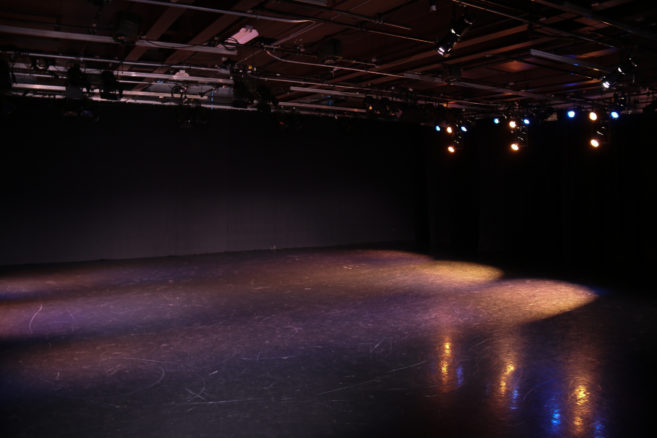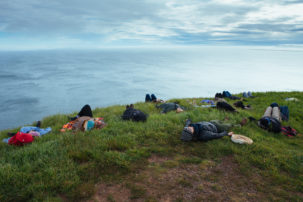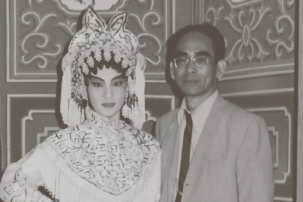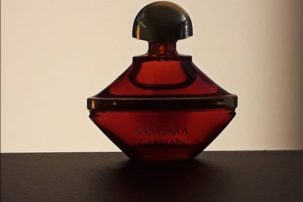Father, we are so full of colour. Our art comes from hands and hair and clay and laughter. Our art is all of our relations dancing together in a moment of stillness before continuing to live on in rock, at the bottom of a waterfall, in our flesh, our children’s smiles. We always exist in multifaceted colour.
In the broadest sense, Anishinaabeg painting is the practice of marking our world. Beyond the confines of galleries and settler aesthetics, canvases and physical tools, Anishinaabeg have always painted our world as a mode of communication inherent within our beautiful bodies. Far from the Western hegemonic conception of painting as bounded by the assumption of linear time, the strictly visual and the non-living canvas, Anishinaabeg painting is rooted in a place beyond time and space, a place where our ancestors dance, a place where Anishinaabeg knowledge lives and breathes. Our art cannot be contained solely on a canvas or within a brush stroke. Our art is an extension of our bodies, and we are always spilling out of the compartmentalizations that structure the settler colonial world. My father, Ron Momogeeshik Peters, and I are both self-taught painters from Treaty 3 Territory. Our visual work is characterized by bold lines and bright colours. But we also paint with stardust and blood. The cold waters of our homelands and the voices of our ancestors are splashed across canvas and contained within our bodies. I am writing this to honour my father and how he has taught me to paint our world with beautiful colour.
Father, you are still so bright. When they stole all of the little Anishinaabeg bodies, the colour of our world reminded them of the hollowness of theirs. They cut you open to gaze upon your bright red blood, but they could not take the colour from your skin. Now you splash colour across canvas and we both laugh deeply into our bellies. We are all that they could never contain.
Anishinaabeg art is always a colourful practice. For us, colour does not exist just in the visual realm but also marks our relationships to the spirit world and binds us to the past, present and future simultaneously. To be colourful is not just to exist in literal colour: it is to be many things all at once, it is to be spilling over this world into the beyond, it is to exist in complicated interconnection. We use colour in our physical artworks to honour this way of being, but we are always colouring our worlds with our footsteps, blood, songs and bodies. For me, settler colonialism is the attempt to contain colour, the attempt to contain our shifting, undefinable and vibrant relationships that define who we are as Anishinaabeg. They tried to take the colour out of my homelands by muddying our waterways with dams. They tried to take the colour out of my father by brutalizing his body in residential school. Amid this violence, my father painted himself back into existence. My father poured colour from his skin when he sat on our homelands in protest of our inability to reside on them. My father painted an Anishinaabeg baby into this world, who learned from him how to paint our world into beautiful colour.
Father, sometimes my body ruptures from the weight of it all. My blood, your blood, Anishinaabeg blood, spilling out of your stomach where they cut you open. But my blood is also paint. Bind my hands and creation still pours out of me. Steal us from our families and we will still paint. Father, when you are confined in a locker for days, a steady stream of Anishinaabeg futures still pours out of your flesh. We are so vibrant and they are muted and colourless.
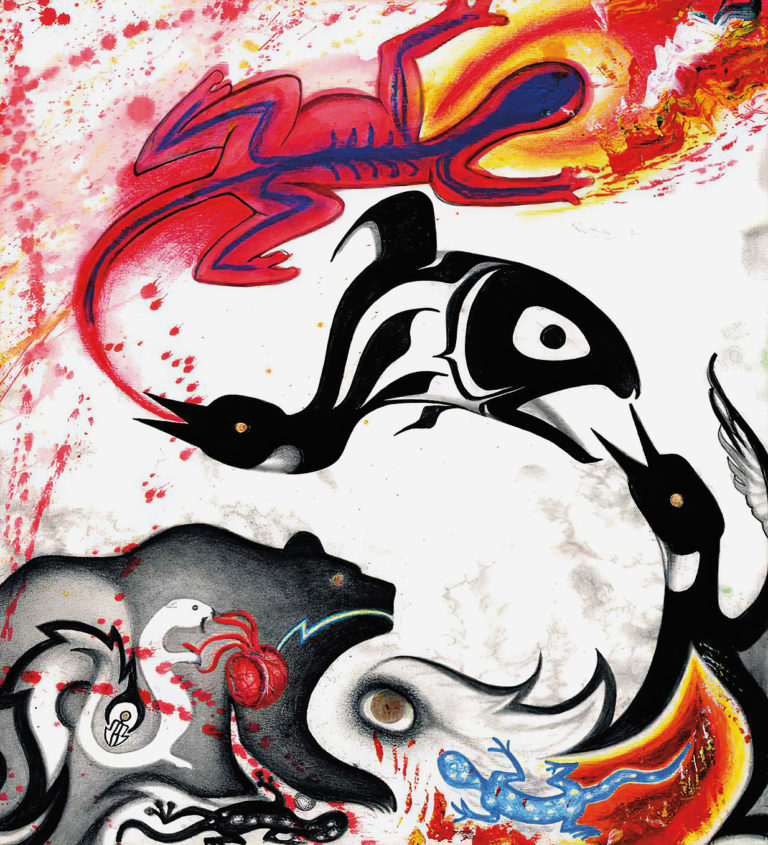 Ron Momogeeshik Peters, Bear Walker, 1990. Acrylic, ink and pencil, 40.6 x 30.4 cm. Courtesy the artist.
Ron Momogeeshik Peters, Bear Walker, 1990. Acrylic, ink and pencil, 40.6 x 30.4 cm. Courtesy the artist.
I could always find my father selling his paintings and carvings on the corner of Bloor and Spadina in Toronto. Always moving, my father flowed in and out of my life. He never taught me how to paint, but he didn’t have to. Our art is inherently intergenerational, taught to us not through technique and skill but through the loving influence of our ancestors as they guide our hands. What my father did teach me was about how to create, as an Anishinaabeg person within a violent settler colonial context. Momogeeshik, the one who pours colour onto everything he touches, the one who dances between gallery and street corner, the one without recognition from a mainstream art world that is always hungry for our art while harming our bodies. Momogeeshik, the one who has endured so much, the one whose body was broken but still remains whole, the one who, when I paint him, I paint as a young boy, so that I can visit him to tell him that our colour will persist. Within my father’s complicated motion, he has always taught me that how we orient our bodies in this world is important. He has always oriented himself not toward the gallery, the career or the palatable, but toward our own bodies, the stars, our homelands. This is how it has always been for Anishinaabeg. This is what he teaches me.
Father, you carve a huge alabaster bear that must have taken you weeks to complete. You throw the bear off a waterfall so that it can live in the water below and speak to those who want to end their lives. Father, you line your body up with the constellations above so that you may dream our visual culture. You leave such gifts across this land, carved bears in still forests waiting to speak, pieces of yourself that you gift to all of our relations.
The erasure, exclusion, commodification and fetishization of Indigenous art within the Western art world has everything to do with the material dispossession of Indigenous bodies and lands. The linear legacy of Indigenous painters constructed by the Western art world in alignment with its own colonial ontology does not recognize the work of so many of us, does not recognize the work of my father. To present the legacy of my father’s work as a painter, I am making visible the labour of spilling over, the labour of orienting one’s self toward an expansive web of creation, the labour of colouring Anishinaabeg worlds back into fullness amid a context of unspeakable violence. Anishinaabeg art lives in all Anishinaabeg bodies, and our legacy is a continuum in motion that is incomprehensible to the hierarchical, linear and containerizing structures of colonial thought. My father, colour beating through his heart, colour living in braids once cut, bright red blood that could not be muted in his stomach once opened, will always spill creation out of his footsteps, painting us into futures that could not be contained.
Father, you teach me so much. Us, Anishinaabeg, always oriented toward our beautiful webs. Us, Anishinaabeg; they are so very lucky when they see our art, when we share these words.
I will be here, standing beside my father, my aunties, my beautiful ancestors who have always painted with colour in motion.

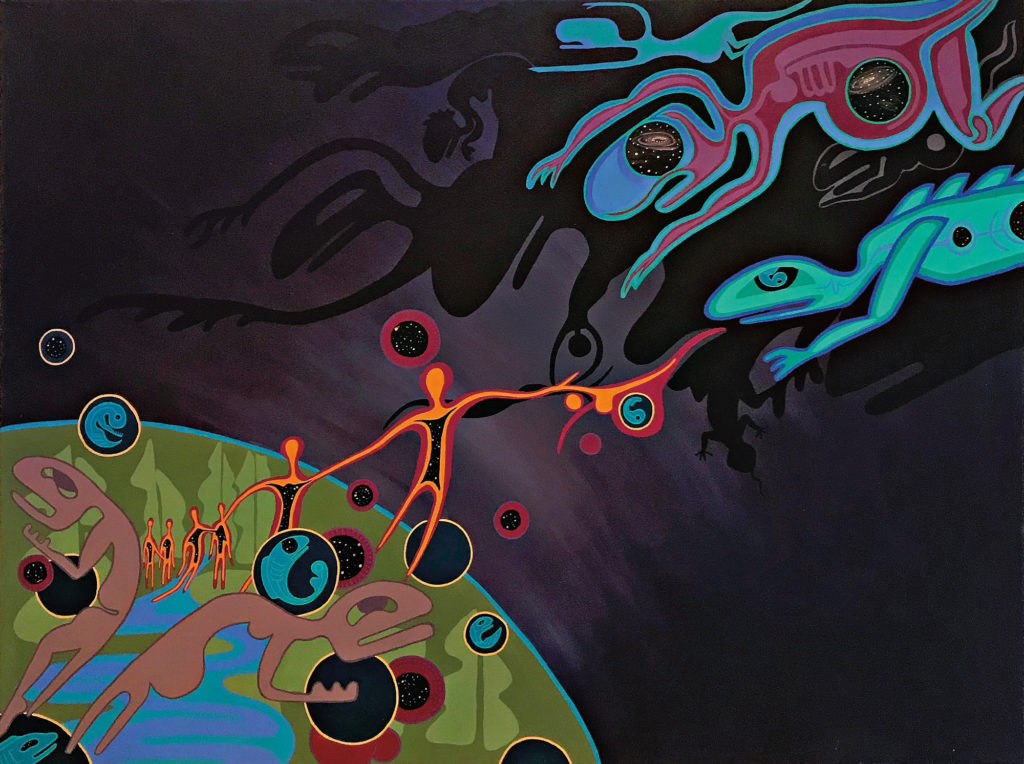 Quill Christie-Peters, Remembering ancestors’ voices from the future, 2018. Acrylic on canvas, 91.4 cm x 1.22 m. Courtesy the artist.
Quill Christie-Peters, Remembering ancestors’ voices from the future, 2018. Acrylic on canvas, 91.4 cm x 1.22 m. Courtesy the artist.
